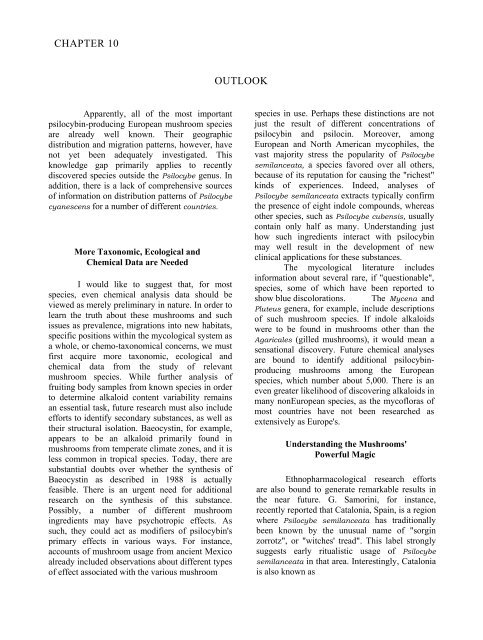Jochen Gartz - Magic Mushrooms Around the ... - preterhuman.net
Jochen Gartz - Magic Mushrooms Around the ... - preterhuman.net
Jochen Gartz - Magic Mushrooms Around the ... - preterhuman.net
You also want an ePaper? Increase the reach of your titles
YUMPU automatically turns print PDFs into web optimized ePapers that Google loves.
CHAPTER 10<br />
OUTLOOK<br />
Apparently, all of <strong>the</strong> most important<br />
psilocybin-producing European mushroom species<br />
are already well known. Their geographic<br />
distribution and migration patterns, however, have<br />
not yet been adequately investigated. This<br />
knowledge gap primarily applies to recently<br />
discovered species outside <strong>the</strong> Psilocybe genus. In<br />
addition, <strong>the</strong>re is a lack of comprehensive sources<br />
of information on distribution patterns of Psilocybe<br />
cyanescens for a number of different countries.<br />
More Taxonomic, Ecological and<br />
Chemical Data are Needed<br />
I would like to suggest that, for most<br />
species, even chemical analysis data should be<br />
viewed as merely preliminary in nature. In order to<br />
learn <strong>the</strong> truth about <strong>the</strong>se mushrooms and such<br />
issues as prevalence, migrations into new habitats,<br />
specific positions within <strong>the</strong> mycological system as<br />
a whole, or chemo-taxonomical concerns, we must<br />
first acquire more taxonomic, ecological and<br />
chemical data from <strong>the</strong> study of relevant<br />
mushroom species. While fur<strong>the</strong>r analysis of<br />
fruiting body samples from known species in order<br />
to determine alkaloid content variability remains<br />
an essential task, future research must also include<br />
efforts to identify secondary substances, as well as<br />
<strong>the</strong>ir structural isolation. Baeocystin, for example,<br />
appears to be an alkaloid primarily found in<br />
mushrooms from temperate climate zones, and it is<br />
less common in tropical species. Today, <strong>the</strong>re are<br />
substantial doubts over whe<strong>the</strong>r <strong>the</strong> syn<strong>the</strong>sis of<br />
Baeocystin as described in 1988 is actually<br />
feasible. There is an urgent need for additional<br />
research on <strong>the</strong> syn<strong>the</strong>sis of this substance.<br />
Possibly, a number of different mushroom<br />
ingredients may have psychotropic effects. As<br />
such, <strong>the</strong>y could act as modifiers of psilocybin's<br />
primary effects in various ways. For instance,<br />
accounts of mushroom usage from ancient Mexico<br />
already included observations about different types<br />
of effect associated with <strong>the</strong> various mushroom<br />
species in use. Perhaps <strong>the</strong>se distinctions are not<br />
just <strong>the</strong> result of different concentrations of<br />
psilocybin and psilocin. Moreover, among<br />
European and North American mycophiles, <strong>the</strong><br />
vast majority stress <strong>the</strong> popularity of Psilocybe<br />
semilanceata, a species favored over all o<strong>the</strong>rs,<br />
because of its reputation for causing <strong>the</strong> "richest"<br />
kinds of experiences. Indeed, analyses of<br />
Psilocybe semilanceata extracts typically confirm<br />
<strong>the</strong> presence of eight indole compounds, whereas<br />
o<strong>the</strong>r species, such as Psilocybe cubensis, usually<br />
contain only half as many. Understanding just<br />
how such ingredients interact with psilocybin<br />
may well result in <strong>the</strong> development of new<br />
clinical applications for <strong>the</strong>se substances.<br />
The mycological literature includes<br />
information about several rare, if "questionable",<br />
species, some of which have been reported to<br />
show blue discolorations. The Mycena and<br />
Pluteus genera, for example, include descriptions<br />
of such mushroom species. If indole alkaloids<br />
were to be found in mushrooms o<strong>the</strong>r than <strong>the</strong><br />
Agaricales (gilled mushrooms), it would mean a<br />
sensational discovery. Future chemical analyses<br />
are bound to identify additional psilocybinproducing<br />
mushrooms among <strong>the</strong> European<br />
species, which number about 5,000. There is an<br />
even greater likelihood of discovering alkaloids in<br />
many nonEuropean species, as <strong>the</strong> mycofloras of<br />
most countries have not been researched as<br />
extensively as Europe's.<br />
Understanding <strong>the</strong> <strong>Mushrooms</strong>'<br />
Powerful <strong>Magic</strong><br />
Ethnopharmacological research efforts<br />
are also bound to generate remarkable results in<br />
<strong>the</strong> near future. G. Samorini, for instance,<br />
recently reported that Catalonia, Spain, is a region<br />
where Psilocybe semilanceata has traditionally<br />
been known by <strong>the</strong> unusual name of "sorgin<br />
zorrotz", or "witches' tread". This label strongly<br />
suggests early ritualistic usage of Psilocybe<br />
semilanceata in that area. Interestingly, Catalonia<br />
is also known as








![The Big Lie 9-11 and Government Complicity in Mass Murder [PDF]](https://img.yumpu.com/50957077/1/190x245/the-big-lie-9-11-and-government-complicity-in-mass-murder-pdf.jpg?quality=85)








